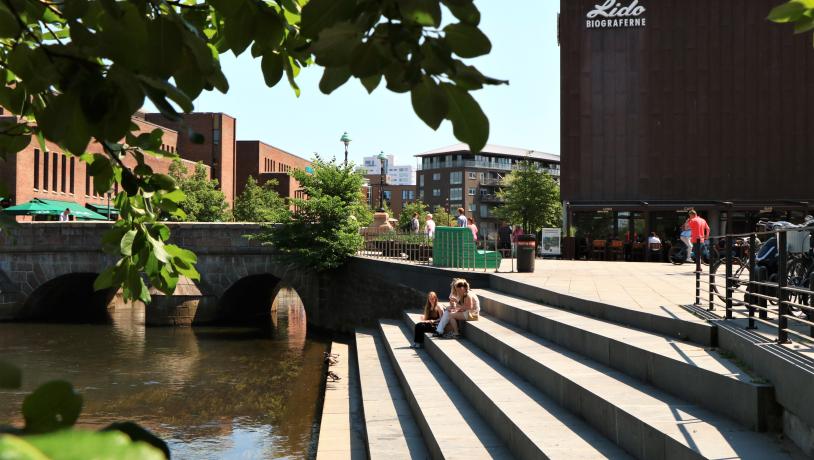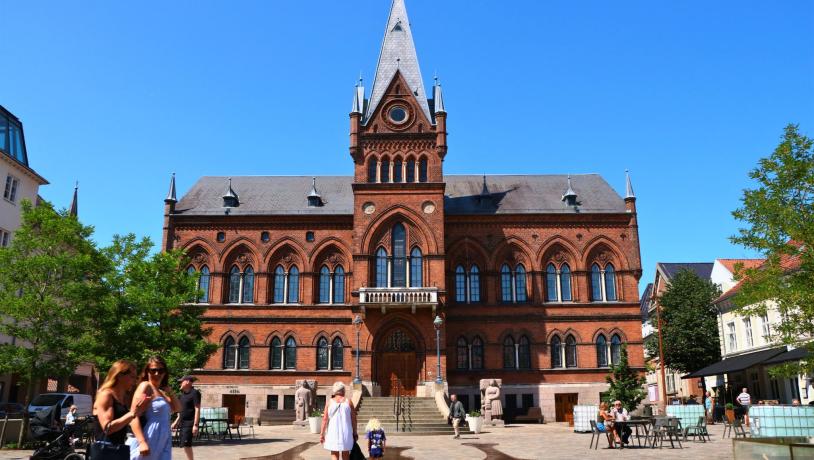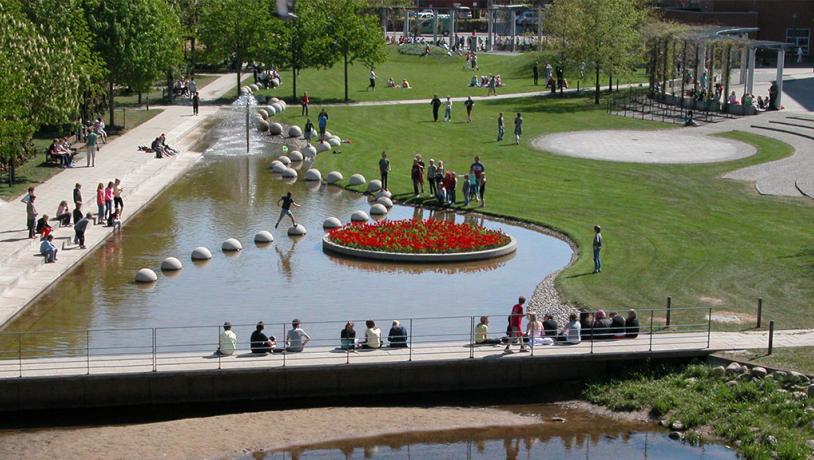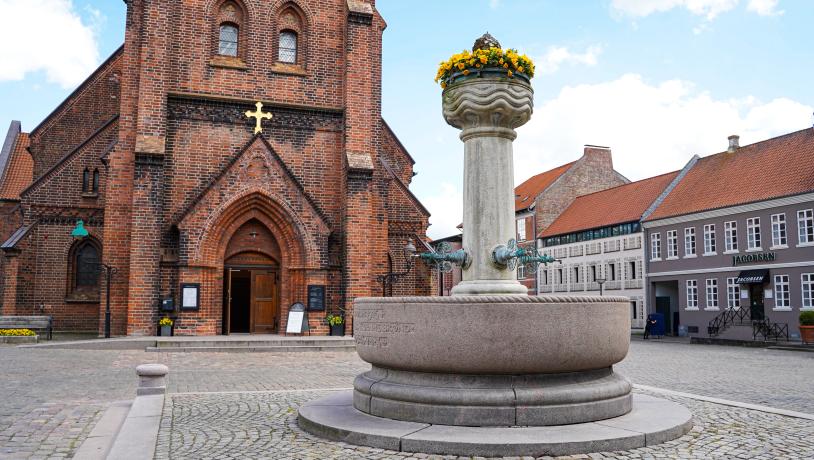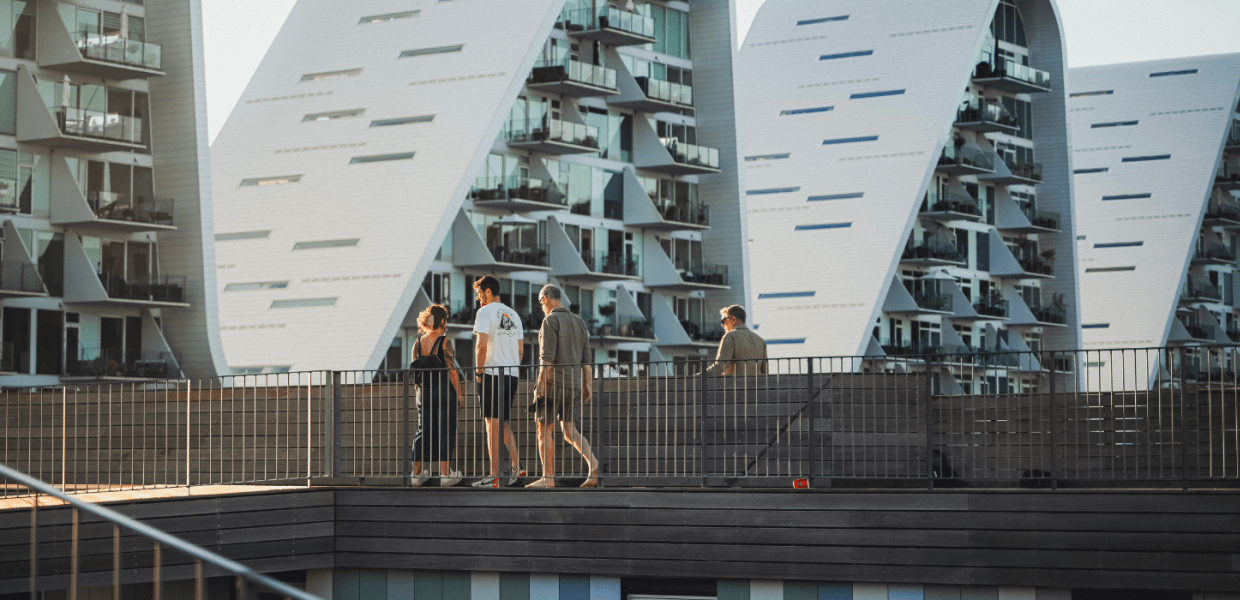City walk in Vejle’s old town
VisitVejle has put together a walking tour through Vejle's old streets. You are invited to join the 4.1 kilometer city walk on your own in Vejle's old town.
VisitVejle welcomes you to a tour of Vejle’s old town.
The trip takes approx. 1 hour and 45 minutes at a leisurely pace, including stops. Enjoy!
On this page you will find:
- Map with route for download as PDF
- An interactive map that you can open with Google Maps
- Description of the city walk and the many exciting stops along the way
The city walk is also available in printed format. You can find it free of charge at VisitVejle's tourist office at Banegårdspladsen 8 in Vejle.
Information for wheelchair users and people with walking difficulties
♿ The route is accessible by wheelchair. However, between the stops Den Smidtske Gård (4) and Rådhustorvet (5) we recommend wheelchair users and people with walking disabilities to take the pedestrian street from Den Smidtske Gård up to Rådhustorvet, instead of going/driving through the courtyard to Fjellegade and Blegbanken.
PDF with map and route for city walk
Start your city walk
1. You are now standing in front of VisitVejle (1), on Banegårdspladsen opposite the main traffic hub, Vejle Trafikcenter. Your route starts here.
Towering above you to your left is artist Bjørn Nørgaard’s 8.5-metre-tall granite sculpture, Himmelstigen – Jacobs drøm, with biblical motifs. The beautiful old building next to the sculpture is Vejle’s old theatre, which also formerly served as a hotel, Teater Hotellet.
2. Walk around the old theatre to the left and cross the street Dæmningen at the pedestrian crossing. Continue along the pavement to the left.
On your right, you will see Økolariet (2), a unique science centre with plenty of interactive learning opportunities about sustainability, the environment, climate and energy
3. Continue straight ahead along Dæmningen and turn right when you reach the river and the town’s cinema, Lido Biograferne.
You are now at Søndertorv. Here you can see the Bryggen shopping centre with its rust-red façade and surrounding buzzing cafés and eateries.
Of special interest is Sønderbroen (3). Here since the Middle Ages, there have been various versions of bridges, which have ensured passage over the river for townspeople and traders. In 1804, the current stone bridge was built, replacing the wooden bridges of earlier times. After renovation in 2008-2009, the bridge has now regained its original appearance, and on the side, you can see the inscription and royal crown marking the year of construction.
Photo:Eliza Danesi
4. Continue up the pedestrian street until you reach Den Smidtske Gård, a magnificent timber-framed building on your left.
Make a short stop here and enjoy the view to Søndertorv.
Vejle Windmill towers majestically over the pedestrian street and the town centre from its hilltop vantage point. The windmill was constructed in 1890 on the original site of the town gallows and has served as a landmark for Vejle for many years. The view is particularly magnificent during dark hours when the mill is floodlit. The windmill was in operation as a grain mill until 1960, and today the milling machinery is still intact. The windmill also houses an exhibition by Vejle Museums about the history of the mill itself and milling in the area. The mill is also the venue of changing art exhibitions by the local art association, Vejle Kunstforening.
5. Walk through the gate on the left to Den Smidtske Gård (4)
The old merchant farm was built in 1799 by merchant A. Ingvard Smidt and constructed by master builder Anders Christensen Kruuse in association with architect and sculptor Jens Hjernøe. Today, the building is the last of Vejle’s old merchant farms and one of the oldest buildings in town. The front house along Søndergade is the oldest section and originally included housing with kitchen, utility room and roll room, granary, warehouse, carriage gate and stables for the horses of visiting merchant tradesmen.
Photo:Eliza Danesi
6. Walk all the way through Den Smidtske Gård and through the gate to Fjellegade. Turn right and walk to Blegbanken and then turn right again towards Rådhustorvet (5).
♿ Recommended for wheelchair users and people with walking difficulties. Between the stops Den Smidtske Gård (4) and Rådhustorvet (5) we recommend wheelchair users and people with walking disabilities to take the pedestrian street from Den Smidtske Gård up to Rådhustorvet, instead of going/driving through the courtyard to Fjellegade and Blegbanken.
Here on the corner of Kirkegade and Torvegade, you can see Residensgaarden where King Christian II, king of Denmark, Norway and Sweden, would occasionally stay until he fled Denmark in the 1520s.
Opposite, you will find Vejle Rådhus (6), the town hall of Vejle that was constructed in 1878-1879 and designed in the neo-Gothic style by architect Carl Lendorf. It was reconstructed in 1920 by Martin Nyrop. The town hall is located on the historic site where the old Blackfriars’ monastery, Sortebrødrekloster, was located in the Middle Ages.
After the first town hall on Gammel Torv was reduced to ashes in 1530, the former monastery became the second town hall of Vejle. In 1780, the third town hall was built on the same site, before finally being replaced by the current municipal building, Vejle’s fourth town hall. The town hall bell, which chimes every day, is the very same bell that once rang for mass at the old monastery. The inscription on the bell reads: “Jesus Mary, I wake the living, I call the dead.”
Also note the two groups of carved figures by Sigurjón Olafsson on either side of the main entrance. The four adult figures symbolise the four trades and professions that have historically shaped the town of Vejle: trade (a scale), craftsmanship (a saw), agriculture (a sheave of grain) and industry (a cogwheel).
Photo:Eliza Danesi
7. Walk around the town hall to your right until you reach Klostergade.
Continue along Klostergade and through the activity park, Mariaparken (7). Regular events are held here and you can play ballgames and go roller-skating, among other things.
8. Cross Flegborg and continue to the right.
On your left, you can see Vejle Art Museum (8). The museum was founded in 1899 and today displays a wide range of art media. The large graphic art collection and the museum extension designed by Kim Utzon with changing exhibitions have made the museum one of Vejle’s absolute highlights.
9. Walk along the street until you reach Vejle Musikteater (9). The music theater in Vejle was inaugurated in 1992 and has made its mark on the town’s cultural life with concerts, plays, musicals and much more.
In front of the music theater, there is a special roundabout that pedestrians can walk through. The fountain that adorns the roundabout is made of steel and granite, and in the evening the many jet streams of water of varying height are illuminated with different colours. To the right of the passage towards the town park, there is a stand with a button that you can press to change the rhythm and height of the water jets.
On the opposite corner, you will see the magnificent mansion, C.M. Hess' villa (10). C.M. Hess’ Jernstøberi was an iron foundry and for many years one of Vejle’s largest and most important industries. Iron stoves and tiled stoves of the best quality were manufactured here. The saying at the time was that the men of Vejle worked at Hess, while the women worked in the cotton industry. Naturally, life in Vejle was never that simple, but this saying does indicate the importance of C.M. Hess for the development of the town. Hess had the mansion constructed in 1906 as his personal residence, and it is the only remaining structure of the iron foundry, which from 1898 until its final closure in 1975 was located where today you find the town park, Byparken.
10. Walk left through Vejle Musikteater’s passage and continue into Byparken (11). In this town park, you can enjoy the many fountains and beautiful greenery. Concerts and events are held here, and the park is used by local residents for recreation.
Photo:VisitVejle
11. Walk through Byparken and continue to the right to the large carpark. Walk through the carpark and follow the path to the right until you reach the roundabout at Nyboesgade and Skolegade. Cross the roundabout and turn right along Aagade.
A little further on, there is a street on the left that leads to Spinderihallerne (12), which were originally cotton-spinning mills from 1896. Vejle was a leading town in the cotton industry. The restored heritage industrial complex is today a meeting point for creative individuals and micro-enterprises.
In addition, Spinderihallerne also houses the Cultural Museum (13).
The museum conveys the history and heritage of Vejle and regularly hosts new and exciting special exhibitions.
12. Walk towards Aagade, cross the street and continue straight down Tønnesgade until you reach Vedelsgade.
Here you turn right and continue until you reach an intersection. Cross to the opposite side of the street and continue in the same direction until you reach a parking area on your left, which you enter.
You have now arrived at Street Art (14). Here you can see 15 large murals on gables and walls created by 11 local and 4 visiting artists. The artworks were created to reflect the theme “We give more than we take.”
13. Walk through the carpark and continue through the passageway out onto the pedestrian street. In the passageway, you can see a commemorative wall plaque that relates the story of a violent blaze and explosion in 1786.
Here, 34 properties were burnt to the ground, while the rest of Nørregade was badly damaged by fire, which made 200 people homeless. The economic losses were extensive, but with cheap building materials, reconstruction soon commenced and the task was largely completed a few months later. In the process, the street had been straightened so that it now appeared as a straight and wide street.
Turn left down the pedestrian street and continue until you reach the small street leading to Paladspassagen Social Dining (15) on the left. The street is easy to recognise due to the splendid coloured houses.
In this food hall, you can enjoy social dining among a large selection of stalls with Danish and exotic street food and events.
Here in the street, you also find the cultural centre, Bygningen.
The building dates from 1920 and was originally created as a Workers’ Assembly Hall. In popular parlance, it was called Bygningen (The Building). Back then, the building was located on its own. Here meetings, festivities and workers’ movement activities took place. The Christmas parties at the hall became an annual tradition that the children in particular looked forward to. To this day, the building remains a cultural centre with various kinds of events, concerts, conferences and creative workshops.
14. Return to the pedestrian street, turn left and continue until you reach Vejle Midtpunkt (16).
You can experience the brightly coloured umbrella sky in this charming alleyway from April to October.
The alley is part of the Vejle Latin Quarter, which includes the upper section of Nørregade, Paladspassagen, Nørretorv and Vestergade. Within this relatively small area, you will find an exciting selection of restaurants, cafés, bars, specialty boutiques, grocers, bakers, chocolatiers & pastry shops. During the summer, a number of stage events are also held in Vejle Midtpunkt, and the colourful area has become a small attraction in itself.
Photo:Mads Hansen
15. Your walk now returns to Nørregade. Here you turn left and cross an arched footbridge. The footbridge takes you over the river of Mølleåen to Nørretorv (17).
Here you can see a large water sculpture and a 16-metre-tall cantilevered light mast created by sculptor Morten Stræde.
Nørretorv has a long history dating back to the Middle Ages. This town square formally marked the boundary of Vejle to the north. Here you also found Vejle Hospital. As the town expanded, the square underwent ongoing transformation to accommodate the intensifying traffic flow. The square has been the location of a roundabout and a bus station. It was also the site of Vejle’s first electric traffic lights in 1961. Today, Nørretorv is a central meeting place with markets and activities.
16. Walk down Dæmningen along the river of Mølleåen.
Creating passageways over Mølleåen are eight simple footbridges in rust-red Corten steel. The railings were designed by different internationally recognised artists, one assigned to each bridge.
Midway down Dæmningen on the opposite side of the street you reach Volmers Plads. Cross the street at the pedestrian crossing.
On the left at Volmers Plads, you will find the multi-storey carpark Tróndur (18). The stairwell at Tróndur is designed with one large, colourful stained-glass window made by Faroese artist Tróndur Patursson. In the evening, the stairwell and its beautiful colours are illuminated from within.
17. Return across the pedestrian crossing and walk towards the river. Continue left along Dæmningen until you reach Vissingsgade on the right.
Here on the historic and charming side street, you will find an exciting selection of small boutiques and speciality stores.
Located on the corner is the Methodist church Sct. Pouls Church (19). The church was consecrated in 1876 and rebuilt and expanded in 1892, at which time it was given its characteristic tower with dome and spire.
18. Continue along Vissingsgade until you return to Vejle’s pedestrian zone. Gågaden (20) consists of Nørregade, Torvegade and Søndergade and is one of Denmark’s longest pedestrian streets. It is paved with Chinese granite, and along the street there are 13 special paving stones inscribed with the original text of the rune stones in Jelling. Search for them as you stroll along the pedestrian street.
Right here on the corner of Vissingsgade where Nørregade leads to Torvegade, you can see small lights in the paving stones during dark hours. On the stand by the building on the right corner, you can change the colour of the lights at the touch of a button.
Also notice the wavy lines in the pedestrian street paving stones a few metres to the left, which delineate the course of the river of Midtåen in the Middle Ages. On one side of this delineation is where Torvegade ended and Nørregade began. Indeed, this is where the two streets merge even to this day.
19. Continue to the left along the Torvegade section of the pedestrian street.
After a few metres, you will reach three glass cases. During the refurbishment of the pedestrian streets in 1999-2001, a 700-year-old cobbled road was found approx. 1 metre below the current street level. This subterranean road has been preserved and you can see the road through the three glass viewing points.
20. Continue along the pedestrian street until you reach Orla Lehmannsgade to the right.
Catching the eye are sculptures by Pontus Kjermann (21): Midgårdsbrønden, Englekatten and Bænke. The horse-like figure entitled Midgårdsbrønden that crowns the fountain was inaugurated in 2001 as the first of the three sculptures.
All three mythological creatures convey a strong visual narrative with numerous exciting and fun references to the history of Vejle and Denmark as part of the artistic design.
21. Continue up the pedestrian street towards Rådhustorvet.
22. Cross the pedestrian crossing and turn left towards Sct. Nikolai Church by Kirketorvet.
Since the Middle Ages, the church square, Kirketorvet, has been a gathering spot for all kinds of activities. It has been a folkmoot and market place and much more. In 1531, most such activities relocated to the current Rådhustorvet, although markets for potters, pewterers and coppersmiths were still held on the old square. The square was also used for entertainment when traveling jongleurs and street artists came to town. This is also here archaeologists have found traces of the first house of Vejle, dated to around 1100.
Photo:Eliza Danesi
Here at the highest point of Vejle, Sct. Nicolai Church (22) was constructed in the mid-thirteenth century, complete with surrounding churchyard.
There are 23 holes in the northern wall of the church. Each hole contains a walled-in human skull, which are placed so you look up through the neck opening into the inner skull, which faces downwards. The origin of these skulls is unknown, but according to legend these are the skulls of 23 robbers, or Polish soldiers from the 30 Years’ War, who were captured in nearby Roms Hule in the seventeenth century and subsequently executed. Their skulls were then embedded in the church wall as a stark public warning.
23. Continue past the church and cross Dæmningen. Turn right and walk across Banegårdspladsen.
You have now returned to your starting point. Here you can visit VisitVejle for further information.
We hope you have enjoyed the trip through Vejle’s old town and wish you a pleasant stay in our town.
